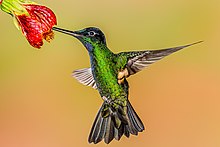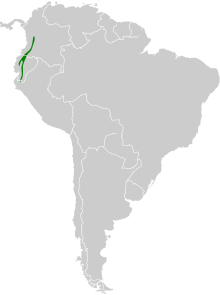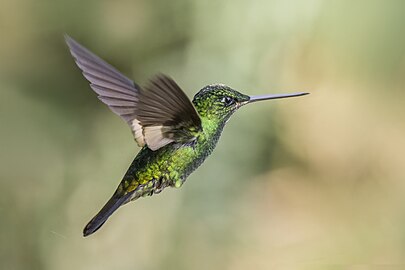| Buff-winged starfrontlet | |
|---|---|

| |
| Male | |

| |
| Female both L. l. lutetiae, Colombia | |
| Conservation status | |
 Least Concern (IUCN 3.1) | |
| CITES Appendix II (CITES) | |
| Scientific classification | |
| Domain: | Eukaryota |
| Kingdom: | Animalia |
| Phylum: | Chordata |
| Class: | Aves |
| Clade: | Strisores |
| Order: | Apodiformes |
| Family: | Trochilidae |
| Genus: | Coeligena |
| Species: | C. lutetiae |
| Binomial name | |
| Coeligena lutetiae (Delattre & Bourcier, 1846) | |

| |
The buff-winged starfrontlet (Coeligena lutetiae) is a species of hummingbird in the "brilliants", tribe Heliantheini in subfamily Lesbiinae. It is found in Colombia, Ecuador, and Peru.
Taxonomy and systematics
The buff-winged starfrontlet and most other members of genus Coeligena were at one time placed in genus Helianthea but have been in their current placement since the mid-1900s. The International Ornithological Committee (IOC) and BirdLife International's Handbook of the Birds of the World (HBW) recognize two subspecies, the nominate C. l. lutetiae and C. l. albimaculata. However, the Clements taxonomy treats the species as monotypic.
Description
The buff-winged starfrontlet is about 14 cm (5.5 in) long. Males weigh 6.9 to 7.2 g (0.24 to 0.25 oz) and females about 6.6 g (0.23 oz). Both sexes have a long, black, slightly upturned bill and a white spot behind the eye. Both sexes have a forked tail though the female's is not as deeply indented as the male's. Males of the nominate subspecies has velvety black upperparts with a glittering green forehead. They have a violet gorget and the rest of the underparts are dark green. The wings are dark with a large cinnamon-buff patch and the tail is bronzy black. Nominate females have shining dark green upperparts. Their throat is cinnamon-buff and the rest of the underparts golden green with pale fringes on the feathers. They have the same cinnamon-buff wing patch as the males but the tail is bronzy green.
Males of subspecies C. l. albimaculata have almost white wing patches but are otherwise like the nominate. Females have a paler throat than the nominate and a cinnamon tinge to the underparts, whose golden green is also less iridescent.
-
 young male C. l. lutetiae, Colombia
young male C. l. lutetiae, Colombia
-
 male C. l. albimaculata
male C. l. albimaculata
Yanacocha Reserve, Ecuador -
 female C. l. albimaculata
female C. l. albimaculata
Yanacocha Reserve, Ecuador
Distribution and habitat
The nominate subspecies of buff-winged starfrontlet is found from the Central Andes of Colombia south through the Andes of Ecuador into far northern Peru. C. l. albimaculata is found only in northwestern Ecuador. The species inhabits cloudforest, elfin forest, and the lower edges of páramo. In elevation it ranges from 2,600 to 4,800 m (8,500 to 15,700 ft) but is most common around 3,000 m (9,800 ft).
Behavior
Movement
The buff-winged starfrontlet is generally sedentary, though some movement to follow flowering plants has been noted.
Feeding
The buff-winged starfrontlet feeds on nectar by trap-lining, visiting a circuit of flowering plants, but it also will defend patches of flowers. It most often forages at low levels at the margins of forest, and often clings to flowers to feed as well as hovering. In addition to feeding on nectar it captures small arthropods by gleaning from foliage and by hawking.
Breeding
The buff-winged starfrontlet's breeding season in Colombia is August and September; it is not defined elsewhere. It builds a cup nest in a branch fork, typically about 2 to 4 m (7 to 13 ft) above ground. The female incubates the clutch of two eggs for 15 to 17 days; the time to fledging has not been determined.
|
Songs and calls Listen to buff-winged starfrontlet on xeno-canto |
Vocalization
The buff-winged starfrontlet makes a "thin, wiry chatter with rattles", often during territorial disputes. While feeding it often repeats "a characteristic, nasal 'unk'".
Status
The IUCN has assessed the buff-winged starfrontlet as being of Least Concern, though its population size is not known and is believed to be decreasing. Though it has a fairly large overall range, its habitat is patchy, fragmented, and under continuing threat of deforestation. It is not thought likely to accept human-made habitats like gardens.
References
- ^ BirdLife International (2016). "Buff-winged Starfrontlet Coeligena lutetiae". IUCN Red List of Threatened Species. 2016: e.T22687837A93171600. doi:10.2305/IUCN.UK.2016-3.RLTS.T22687837A93171600.en. Retrieved 2 May 2022.
- "Appendices | CITES". cites.org. Retrieved 2022-01-14.
- ^ Gill, F.; Donsker, D.; Rasmussen, P., eds. (January 2022). "Hummingbirds". IOC World Bird List. v 12.1. Retrieved January 15, 2022.
- ^ HBW and BirdLife International (2020) Handbook of the Birds of the World and BirdLife International digital checklist of the birds of the world Version 5. Available at: http://datazone.birdlife.org/userfiles/file/Species/Taxonomy/HBW-BirdLife_Checklist_v5_Dec20.zip retrieved 27 May 2021
- Remsen, J. V., Jr., J. I. Areta, E. Bonaccorso, S. Claramunt, A. Jaramillo, D. F. Lane, J. F. Pacheco, M. B. Robbins, F. G. Stiles, and K. J. Zimmer. Version 31 January 2022. A classification of the bird species of South America. American Ornithological Society. https://www.museum.lsu.edu/~Remsen/SACCBaseline.htm retrieved February 1, 2022
- Clements, J. F., T. S. Schulenberg, M. J. Iliff, S. M. Billerman, T. A. Fredericks, J. A. Gerbracht, D. Lepage, B. L. Sullivan, and C. L. Wood. 2021. The eBird/Clements checklist of Birds of the World: v2021. Downloaded from https://www.birds.cornell.edu/clementschecklist/download/ Retrieved August 25, 2021
- ^ Züchner, T., P. F. D. Boesman, and G. M. Kirwan (2020). Buff-winged Starfrontlet (Coeligena lutetiae), version 1.0. In Birds of the World (J. del Hoyo, A. Elliott, J. Sargatal, D. A. Christie, and E. de Juana, Editors). Cornell Lab of Ornithology, Ithaca, NY, USA. https://doi.org/10.2173/bow.buwsta1.01 retrieved 2 May 2022
